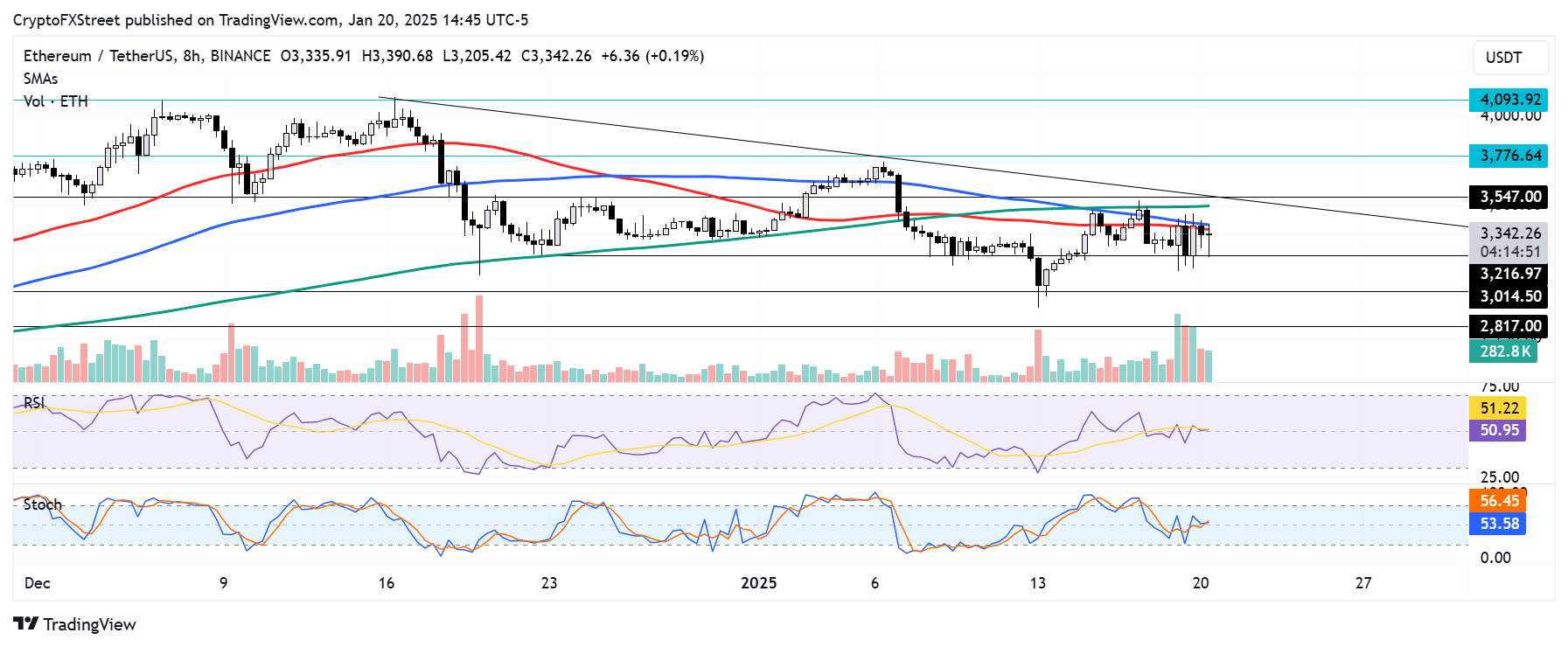Ethereum Price Forecast: ETH set for rally as its Foundation allocates 50,000 ETH to DeFi
Ethereum price today: $3,330
- The Ethereum Foundation announced that it would allocate 50,000 ETH to participate in DeFi activities.
- The announcement follows criticisms that the Foundation only uses the Ethereum blockchain for selling its holdings.
- Ethereum could rally 20% to test the $4,093 resistance if it overcomes a key descending trendline hurdle.
Ethereum (ETH) trades around $3,330 on Monday following the general crypto market decline stemming from traders' reaction to Unites States (US) President Donald Trump's failure to mention crypto during his inauguration. However, the top altcoin could be set for a positive year after the Ethereum Foundation allocated 50,000 ETH to the decentralized finance (DeFi) ecosystem in response to criticisms surrounding its selling activity.
Ethereum Foundation responds to criticisms with 50,000 ETH DeFi allocation
The Ethereum Foundation announced in an X post that it had allocated 50,000 ETH from its treasury to begin participating in the DeFi ecosystem — starting with a test transaction on the Aave lending protocol.
This follows criticisms the Foundation faced earlier on Monday for selling another 100 ETH. Most crypto community members alleged that the Foundation only used the Ethereum blockchain for selling ETH, highlighting the $13.3 million sales it had made over the past year.
Angel investor Eric Conner suggested that the Foundation stakes a portion of its ETH holdings to cushion the effect of its selling activity and cover up expenses.
However, Ethereum co-founder Vitalik Buterin responded that the Foundation had historically opted not to stake due to concerns of regulatory risk and being forced to choose a side if a contentious hard fork occurs.
The concerns historically were (1) regulatory, (2) if EF stakes ourselves, this de-facto forces us to take a position on any future contentious hard fork.
— vitalik.eth (@VitalikButerin) January 20, 2025
(1) is less than before, (2) remains. There's definitely ways to minimize (2), and we're recently been exploring them.
He noted that while regulatory risks have been reduced, the Foundation is still exploring ways to navigate the second challenge.
Additionally, Tim Beiko, who runs the core protocol meetings at Ethereum, highlighted that staking the remaining balance of the Ethereum Foundation treasury — ~269,000 ETH — at the current average annual yield of 3% will only bring in ~8,000 ETH worth about $26 million. This accounts for less than 20% of the Foundation's $134.7 million total spending in 2025.
"I'm all for using the chain and staking when it makes sense [...], but staking wouldn't cover all EF spending, and [in my opinion] it'd be reckless to lever up on the ETH treasury to cover payroll,” wrote Beiko.
However, with the 50,000 ETH allocation to DeFi, the Foundation could start growing its ETH's holdings by earning across a wide range of yield-generation opportunities.
The latest updates come after Buterin announced that the Foundation is undergoing "large changes" to its leadership structure, which include bringing in fresh talent and improving the level of technical expertise, amongst others.
Meanwhile, Ethereum ETFs recorded net inflows of $246 million last week, per CoinShares data.
Ethereum Price Forecast: ETH could rally 20% to $4,093 if it overcomes descending trendline resistance
Ethereum saw nearly $180 million in futures liquidations in the past 24 hours, per Coinglass data. The total amount of liquidated long positions is $133.52 million, while short liquidations accounted for $46.45 million.
On Monday, the top altcoin continued consolidating between the $3,200 and $3,500 range after bouncing off the $3,216 support level.
Notably, ETH faces resistance near the 100-day Simple Moving Average (SMA) and a descending trendline extending from December 16. If ETH clears this resistance, it could overcome the $3,776 hurdle and rally to test its ten-month high resistance near $4,100.

ETH/USDT 8-hour chart
However, a rejection at the descending trendline could send ETH to find support near the $3,216 level. If this support fails, the $3,000 psychological level could prevent a further decline.
The Relative Strength Index (RSI) and Stochastic Oscillator (Stoch) momentum indicators have crossed above their neutral levels, indicating rising bullish momentum.
A daily candlestick close below $2,817 will invalidate the thesis.
Ethereum FAQs
Ethereum is a decentralized open-source blockchain with smart contracts functionality. Its native currency Ether (ETH), is the second-largest cryptocurrency and number one altcoin by market capitalization. The Ethereum network is tailored for building crypto solutions like decentralized finance (DeFi), GameFi, non-fungible tokens (NFTs), decentralized autonomous organizations (DAOs), etc.
Ethereum is a public decentralized blockchain technology, where developers can build and deploy applications that function without the need for a central authority. To make this easier, the network leverages the Solidity programming language and Ethereum virtual machine which helps developers create and launch applications with smart contract functionality.
Smart contracts are publicly verifiable codes that automates agreements between two or more parties. Basically, these codes self-execute encoded actions when predetermined conditions are met.
Staking is a process of earning yield on your idle crypto assets by locking them in a crypto protocol for a specified duration as a means of contributing to its security. Ethereum transitioned from a Proof-of-Work (PoW) to a Proof-of-Stake (PoS) consensus mechanism on September 15, 2022, in an event christened “The Merge.” The Merge was a key part of Ethereum's roadmap to achieve high-level scalability, decentralization and security while remaining sustainable. Unlike PoW, which requires the use of expensive hardware, PoS reduces the barrier of entry for validators by leveraging the use of crypto tokens as the core foundation of its consensus process.
Gas is the unit for measuring transaction fees that users pay for conducting transactions on Ethereum. During periods of network congestion, gas can be extremely high, causing validators to prioritize transactions based on their fees.

